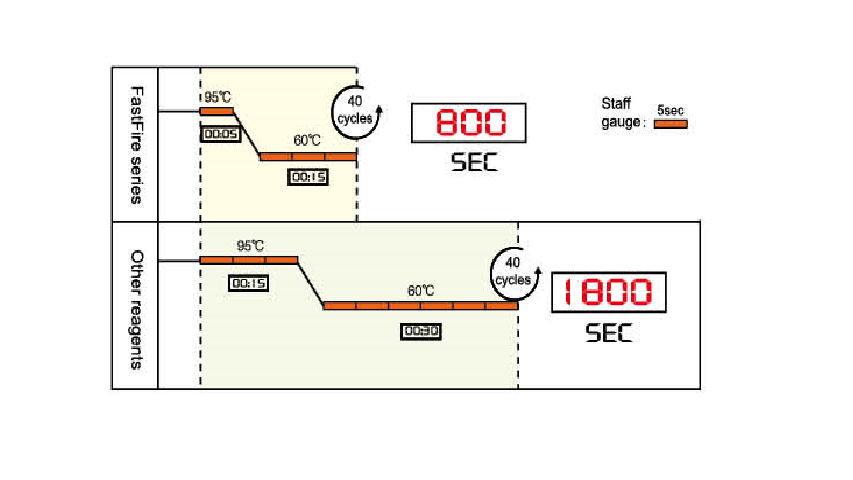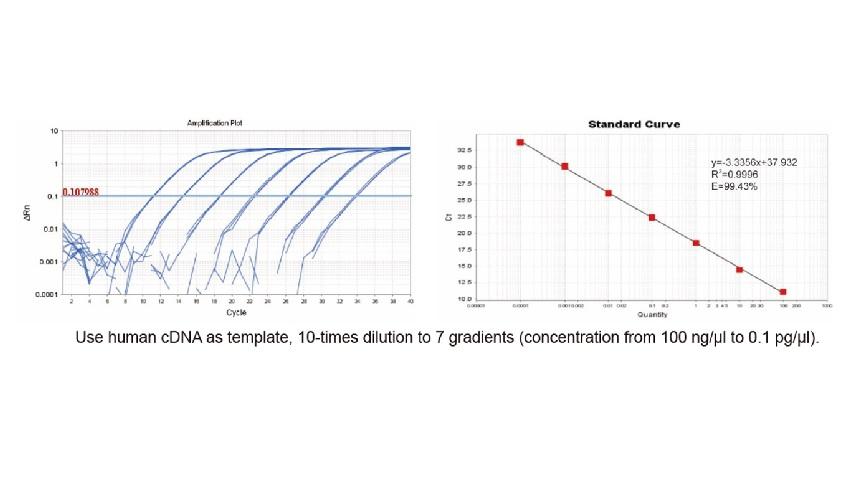Catalog Number|Packaging
Mat. No |
Ref. No |
No. of preps |
|
4992221 |
GFP208-02 | 20 µl×500 rxn |
-
Features
● FastFire qPCR PreMix employs a specific antibody-modified hot-start DNA polymerase in conjunction with a carefully optimized Buffer system, resulting in a 60% shorter PCR reaction time than typical qPCRs and featuring accurate quantitation, high amplification efficiency, reproducibility, and a wide confidence range.
● This product has been optimized to achieve excellent fluorescence signal release, while fully degrading the signal release from the fluorescence quenching groups of the probe, and a stronger signal will be obtained with the same amount of template.
● FastFire qPCR PreMix is in the form of 2× pre-mix. When preparing the PCR reaction solution, users only need to add templates, primers, probe, and ddH2O to carry out the Real-Time PCR reaction, which is easy and convenient to operate.
● This product comes with ROX Reference Dye, which is used to eliminate the signal background as well as calibration of fluorescence signal error generated between wells, making it convenient for customers to choose the corresponding concentration for different models of fluorescence quantitative PCR instruments.
-
Description
FastFire qPCR PreMix (Probe) is designed for probe based quantitative PCR assays, enables fast and specific quantitative results with total running time 60% reduced compared with regular real-time PCR. FastFire qPCR PreMix is ready to use with premix including hot-start DNA Polymerase and unique PCR buffer. It could ensure a sensitive PCR detection on any Real-Time PCR thermal cycler.
-
Kit Contents
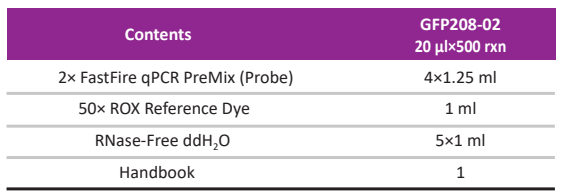
-
Storage Condition
FastFire qPCR PreMix (Probe) can be stored at -30~-15°C for one year. It should be stored immediately upon receipt at -30~-15°C. 2× FastFire qPCR PreMix (Probe) and 50× ROX Reference Dye should be thawed and then mixed upside down gently to be homogenous before using. If the Reagents have been thawed but not used, it is important to thoroughly mix prior to re-freezing. (The layering of salts during the thawing process and subsequent crystallization during freezing will damage the enzyme and decrease product performance.) The reagents could be stored for up to 3 months at 2-8°C if frequently used. Please avoid refreezing and thawing repeatedly.
-
Important Notes
● The hot-start DNA polymerase is recommended to be activated at the start of reaction: for cDNA template by a 30-60 sec, 95°C incubation step; for gDNA template by 98°C, 1-2 min.
● The performance will decrease if the reagents are not mixed thoroughly. Gently mix the reagents by inverting the tubes and centrifuge briefly prior to use. DO NOT vortex and avoid producing bubble.
● Fluorescence probe is not included in this kit.
● 0.2 µM concentration of probe, 0.3 µM concentration of primer could achieve excellent amplification result for most systems. If need further optimization, primer concentration could be adjusted between 0.05-0.9 µM, and probe concentration between 0.1-0.5 µM.
● In a 20 µl reaction volume, the amounts of genome DNA or cDNA template is usually less than 100 ng. The reverse transcription product, if used as template, should not comprise more than 20% of the total PCR reaction volume.
-
Principle of the Kit
This product employs a specific antibody-modified hot-start DNA polymerase for PCR amplification. The purpose of detecting PCR product amplification is achieved by adding a fluorescent probe to the PCR reaction solution and then detecting the fluorescence intensity during the reaction process.
● The specific antibody modified hot-start DNA polymerase in this product can activate all the enzyme activities by incubating at 95°C for 1 min. Meanwhile, together with the carefully optimized Buffer system, it can greatly shorten the denaturation, annealing and extension time, so as to shorten the total running time of PCR by 60%, obtain the results of the experiment faster without affecting the effect of the PCR reaction, and it has the characteristics of accurate quantitation, high amplification efficiency, good reproducibility and wide confidence range.
● This product is specially optimized for the differences in the structural composition of cDNA templates and gDNA templates, and the PCR reaction steps are optimized so that good PCR results can be obtained even for the more difficult-to-amplify gDNA templates.
● This product has been optimized to facilitate the 5'-3' exonuclease activity of Taq enzyme, so that the release of fluorescent signals can achieve excellent results. In addition the FastFire qPCR PreMix system also sufficiently degrades the signal release from the fluorescence quenching moiety of the probe, and with the above optimization, a stronger signal will be obtained with the same amount of template.
-
Description of Primer Design
The design of PCR primer is very important when performing Real-time PCR reactions. The design of primer with high PCR amplification efficiency and reaction specificity can be referred to the following requirements.
The requirements for designing primer are as follows:

-
Description of Probe Design
Please prepare a fluorescent probe suitable for the target gene sequence. For the design of Probe sequences, please refer to the design guide for each Probe.
In addition, please use Probe purified at HPLC grade or above whenever possible, otherwise residual unbound fluorescent dyes will cause the baseline to drift upwards thus reducing the sensitivity of the assay.
-
Trouble Shooting
● Chaos of amplification curve and weak fluorescence signal due to low concentration of template.
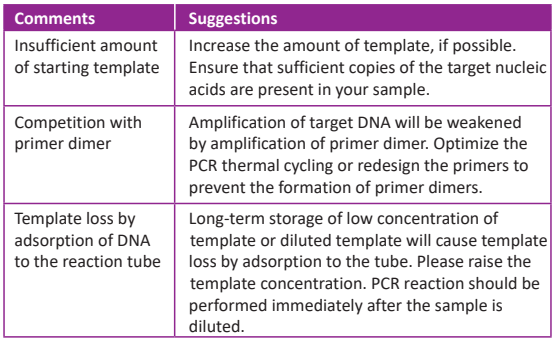
● Positive signal in no-template control (NTC).
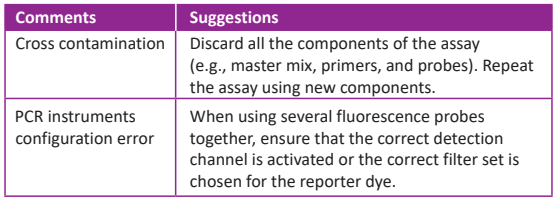
● Poor repeatability of CT value.
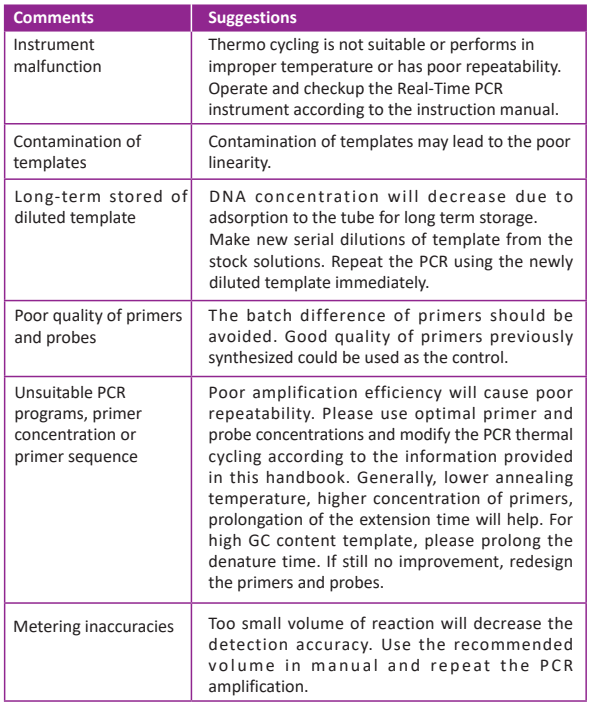
● Amplification efficiency less than 90% (slope < -3.6).
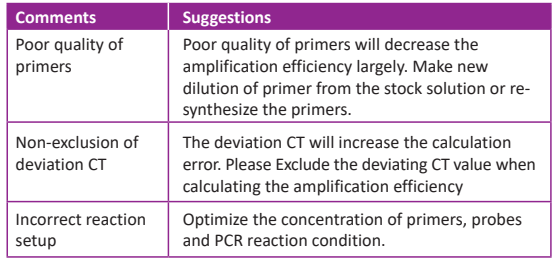
● Amplification efficiency over 110% (slope > -3.1).
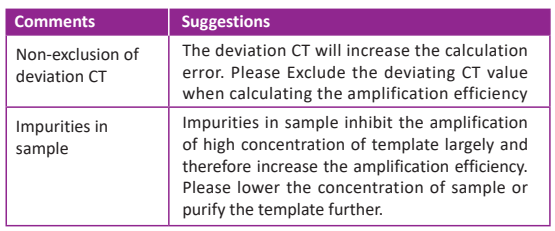
● Poor fluorescence signal or zigzag amplification curve.
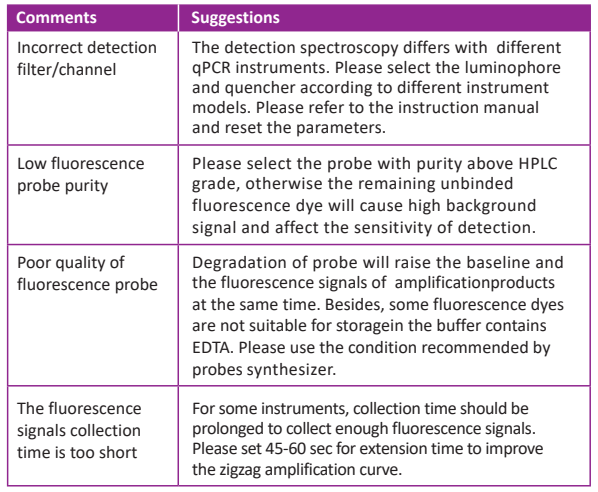
Experimental Example
Fastest-Improve the experiment efficiency, prolong the service life of the instrument and save energy.
The Anti Taq DNA polymerase can be activated rapidly. Combined with unique Buffer system, it is currently the fastest Probe reagent on the market.
The fastest Probe reagent at present, which shortens the reaction time by 1000 sec.
-
Sort by
-
Date
Date(
)
Date
Date(
)
Impact Factor
IF(
)
Impact Factor
IF(
)



 Inquire
Inquire